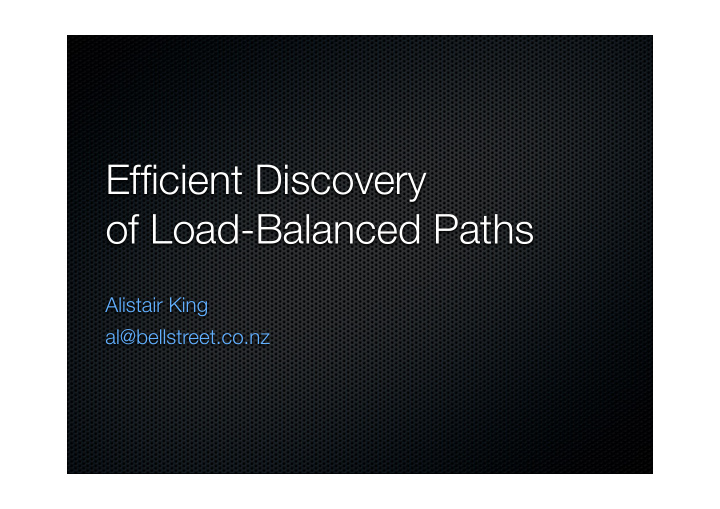



Efficient Discovery of Load-Balanced Paths Alistair King al@bellstreet.co.nz
Load-Balancer Traceroute Gives confidence that the complete topology has been discovered. Probes each TTL repeatedly to discover alternate interfaces. Uses a large number of probes (and therefore a long amount of time)
Load-Balancer Traceroute E.g. To discover, with 99% confidence, a hypothetical path with 5 hops and 9 interfaces, >= 74 probes would be sent. Compared with >= 5 probes for regular traceroute TTL: 1 2 3 4 5 Probes: 8 + 29 + 21 + 8 + 8 = 74
Doubletree traceroute More efficient version of conventional traceroute algorithm. Assumes Internet paths form trees. Probes forward from a midpoint in the path until a known interface or the destination is reached. Probes backward from the midpoint, again until a known interface or the beginning of the path is reached. Empirical testing of scamper doubletree implementation gives 95% coverage whilst sending 77% fewer probes.
Doubletree Load-Balancer Developed and tested last year as part of my honors research. Goal is to reduce the number of probes that load- balancer traceroute uses. Uses a doubletree-like algorithm to determine an initial TTL for the load-balancer traceroute algorithm to probe from.
Doubletree Load-Balancer Probes backward from a midpoint until a known hop is discovered. Initial Probe (TTL 4) Known Interfaces
Doubletree Load-Balancer Probes known hop multiple times to discover alternate interfaces. Sends 21 probes to TTL 3 Discovers 2 alternate interfaces
Doubletree Load-Balancer Follows the paths from each alternate interface back to their convergence point. This ensures that no alternate paths are missed
Doubletree Load-Balancer Probes forward using load-balancer traceroute until a known interface is discovered. Testing shows that dtlb maintains 96% coverage compared to tracelb, whilst sending 31% fewer probes
Doubletree Load-Balancer Analysis shows that most missed links are probably due to per-destination load-balancing, causing alternate paths to be missed. Idea is to keep state about how many paths an interface is seen in when probing different destinations. Only stop probing at an interface if it has been seen in the path to x (8?) destinations.
BGP Influenced Probing Goal is to use knowledge of BGP routes to infer which segments of a path have not been probed before. Used BGP tables to map interfaces to AS number. Whilst probing, keep track of the average size of each AS. Once an AS has been transited enough times to have an accurate average width, use that width to allow future traces to skip over the AS. Used existing Ark data to run simulations.
BGP Simulator ! Address Counts 1.2e+06 unique addresses probes used 1e+06 800000 address count probe count 600000 400000 200000 0 0 20 40 60 80 100 120 140 160 180 200 confidence value What is the optimal number of times to transit an AS in order to minimize probe numbers and maximize address count? Makes little difference to the number of addresses discovered ~20 times appears to be optimal in terms of probes used
Doubletree and Ark Developing a set of scripts which will allow large-scale doubletree measurements to be made using the Ark infrastructure. Doubletree is implemented in scamper trunk Use Marinda to drive multiple doubletree monitors and allow them to share their stop set data with each other
Algorithm Simulator Concept: A tracing simulator which allows new algorithms to be quickly and easily tested. Written in Ruby to allow a quick development cycle and dynamic addition of new algorithms. Uses Ark trace data to drive the simulator. Currently have trace and doubletree algorithm plugins Simulated performance is very close to real-world performance
Where to from here? Investigate dtlb per-destination improvements mentioned earlier. Re-investigate doubletree load-balancer to determine where other improvements can be made. Continue investigations into using BGP to direct probing. Complete implementation of doubletree ark coordination scripts. Conduct large-scale measurements using doubletree
Questions, Suggestions?
Recommend
More recommend